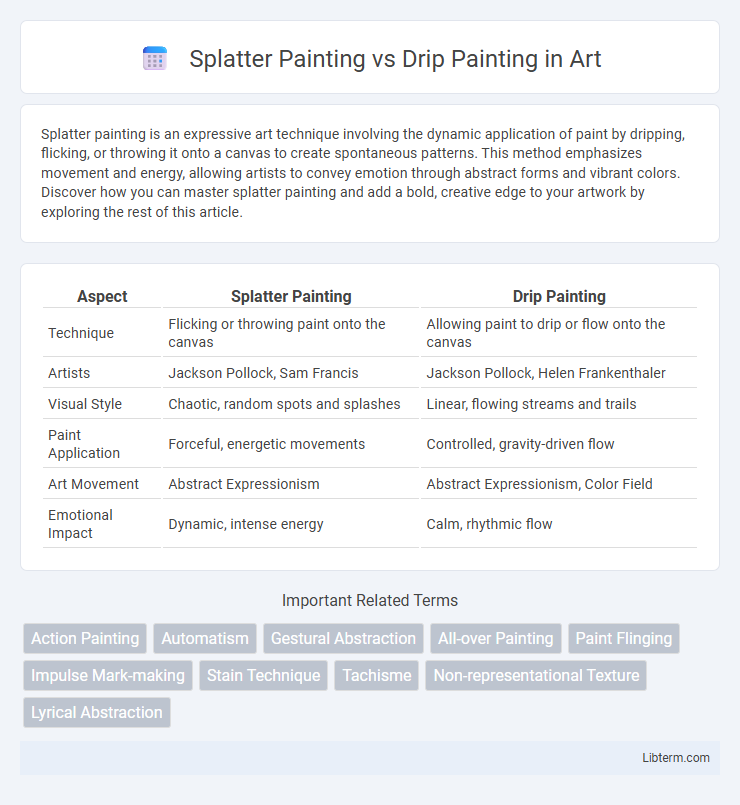Splatter painting is an expressive art technique involving the dynamic application of paint by dripping, flicking, or throwing it onto a canvas to create spontaneous patterns. This method emphasizes movement and energy, allowing artists to convey emotion through abstract forms and vibrant colors. Discover how you can master splatter painting and add a bold, creative edge to your artwork by exploring the rest of this article.
Table of Comparison
| Aspect | Splatter Painting | Drip Painting |
|---|---|---|
| Technique | Flicking or throwing paint onto the canvas | Allowing paint to drip or flow onto the canvas |
| Artists | Jackson Pollock, Sam Francis | Jackson Pollock, Helen Frankenthaler |
| Visual Style | Chaotic, random spots and splashes | Linear, flowing streams and trails |
| Paint Application | Forceful, energetic movements | Controlled, gravity-driven flow |
| Art Movement | Abstract Expressionism | Abstract Expressionism, Color Field |
| Emotional Impact | Dynamic, intense energy | Calm, rhythmic flow |
Introduction to Splatter and Drip Painting
Splatter painting and drip painting are dynamic abstract art techniques that emphasize spontaneous application of paint. Splatter painting involves flicking or throwing paint onto the canvas, creating random, energetic patterns, while drip painting relies on controlled dripping or pouring of paint to form intricate, flowing lines and shapes. Both styles gained prominence through artists like Jackson Pollock, showcasing expression through motion and texture.
Historical Background and Origins
Splatter painting, famously associated with Jackson Pollock in the 1940s, emerged from the Abstract Expressionist movement, emphasizing spontaneous, dynamic application of paint through flicking or throwing. Drip painting, a subset of splatter techniques, also pioneered by Pollock, originated as an innovative method of dripping liquid paint onto horizontal canvases to capture movement and energy. Both styles reflect a break from traditional brushwork, rooted in avant-garde efforts to explore subconscious creativity post-World War II.
Key Techniques: Splatter vs Drip
Splatter painting involves flicking or throwing paint onto a canvas, creating dynamic, random patterns with high energy and texture, often emphasizing chaotic motion. Drip painting, made famous by Jackson Pollock, requires controlled dripping or pouring paint in thin streams, allowing for more deliberate layering and intricate webs of color. Both techniques use gravity and fluidity, but splatter emphasizes abrupt, explosive marks, whereas drip focuses on continuous, flowing lines.
Influential Artists in Each Style
Jackson Pollock is the most influential artist in drip painting, known for his groundbreaking "action painting" technique that involves dripping and pouring paint onto large canvases to create dynamic, abstract compositions. In contrast, splatter painting, often considered a subset of abstract expressionism, features artists like Sam Francis, whose energetic and colorful splatters emphasize spontaneity and texture. Both styles revolutionized the perception of painting by prioritizing the physical act of creation and emotional expression over traditional forms.
Tools and Materials Used
Splatter painting utilizes brushes, sticks, or even flicking devices to scatter thick, viscous paints like acrylics or oils onto a canvas, creating dynamic, textured surfaces. Drip painting relies on thin, fluid paints such as enamel or liquid acrylics dropped or poured directly from containers or sticks, allowing gravity to form intricate, unpredictable lines and pools. Both techniques emphasize movement, but splatter painting often requires more controlled tools for varied texture, while drip painting depends on paint consistency and gravity for its characteristic flow patterns.
Visual Impact and Aesthetic Differences
Splatter painting generates a chaotic and energetic visual impact through the random dispersion of paint droplets, creating a dynamic texture with vibrant layers. Drip painting presents a more controlled aesthetic, characterized by elongated, gravity-driven lines that evoke a sense of movement and rhythm. The splatter technique often results in a dense, intricate pattern, while drip painting emphasizes linearity and flow, influencing emotional responses and interpretive depth.
Artistic Intent and Expression
Splatter painting emphasizes energetic, dynamic gestures that capture the artist's spontaneous emotional expression, often resulting in chaotic yet intentional compositions. Drip painting focuses on controlled, rhythmic application of paint, allowing subtle variations in flow and layering to convey meditative or subconscious artistic intent. Both techniques prioritize process and movement, but splatter painting channels raw emotion while drip painting explores deliberate exploration of form and texture.
Popular Works and Iconic Examples
Splatter painting, famously exemplified by Jackson Pollock's "No. 5, 1948," showcases energetic, chaotic bursts of paint on canvas, embodying abstract expressionism with dynamic texture and movement. Drip painting, also popularized by Pollock, involves more controlled, deliberate lines and trails of paint, as seen in "Convergence" (1952), highlighting rhythm and intricate layering. Both styles revolutionized modern art by emphasizing spontaneity and emotional intensity through innovative techniques.
Modern Adaptations and Trends
Modern adaptations of splatter painting emphasize vivid color contrasts and controlled chaos, often incorporating digital tools to enhance precision and repeatability. Drip painting trends highlight fluid dynamics and organic patterns, with artists experimenting using unconventional materials like resin and metallic paints to create textured, multidimensional effects. Both styles merge traditional techniques with technology, expanding creative possibilities in contemporary art.
Choosing Your Style: Which Suits You Best?
Splatter painting, characterized by energetic, spontaneous flicks of paint, appeals to those who embrace chaos and bold expression; drip painting, popularized by Jackson Pollock, offers a more fluid, controlled flow of color that suits individuals seeking rhythm and layered texture. Consider your artistic intent and emotional connection: splatter painting captures raw dynamism, while drip painting allows for meditative repetition and depth. Experimenting with both methods helps identify whether you resonate more with dynamic action or contemplative process in your creative journey.
Splatter Painting Infographic

 libterm.com
libterm.com